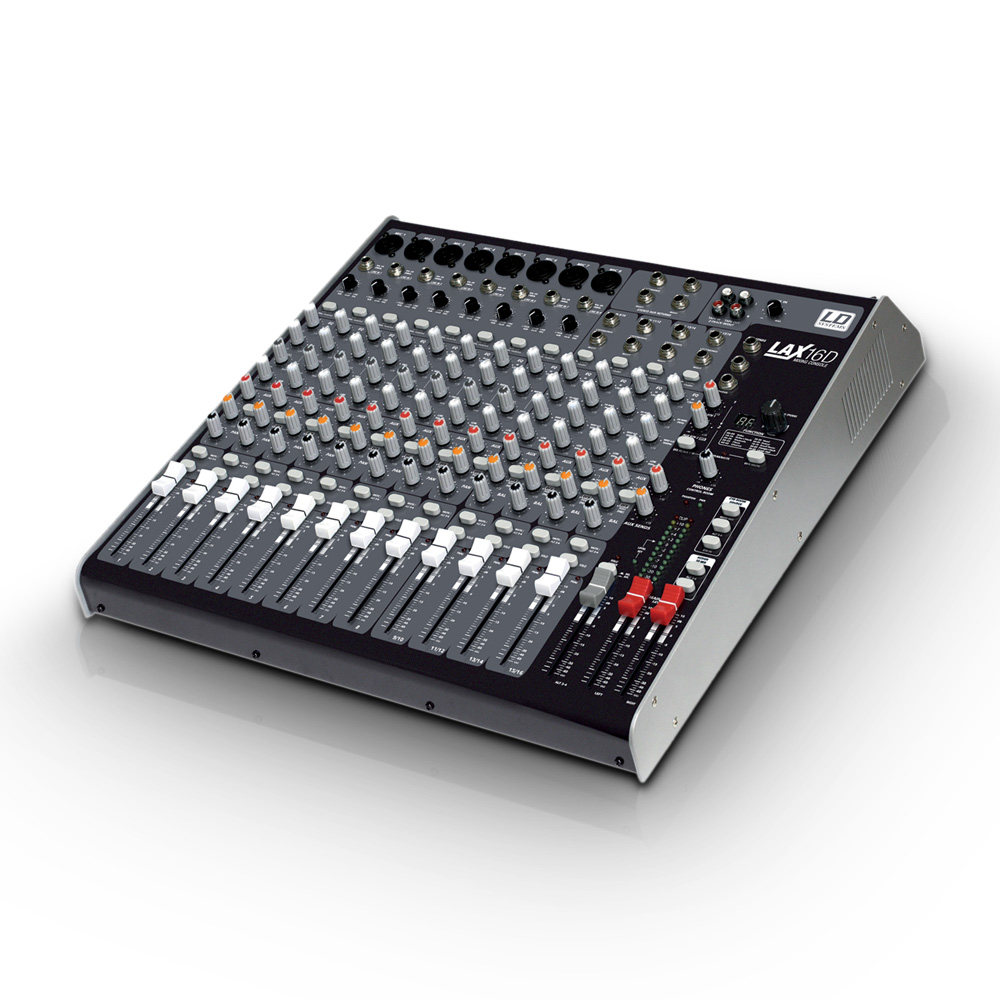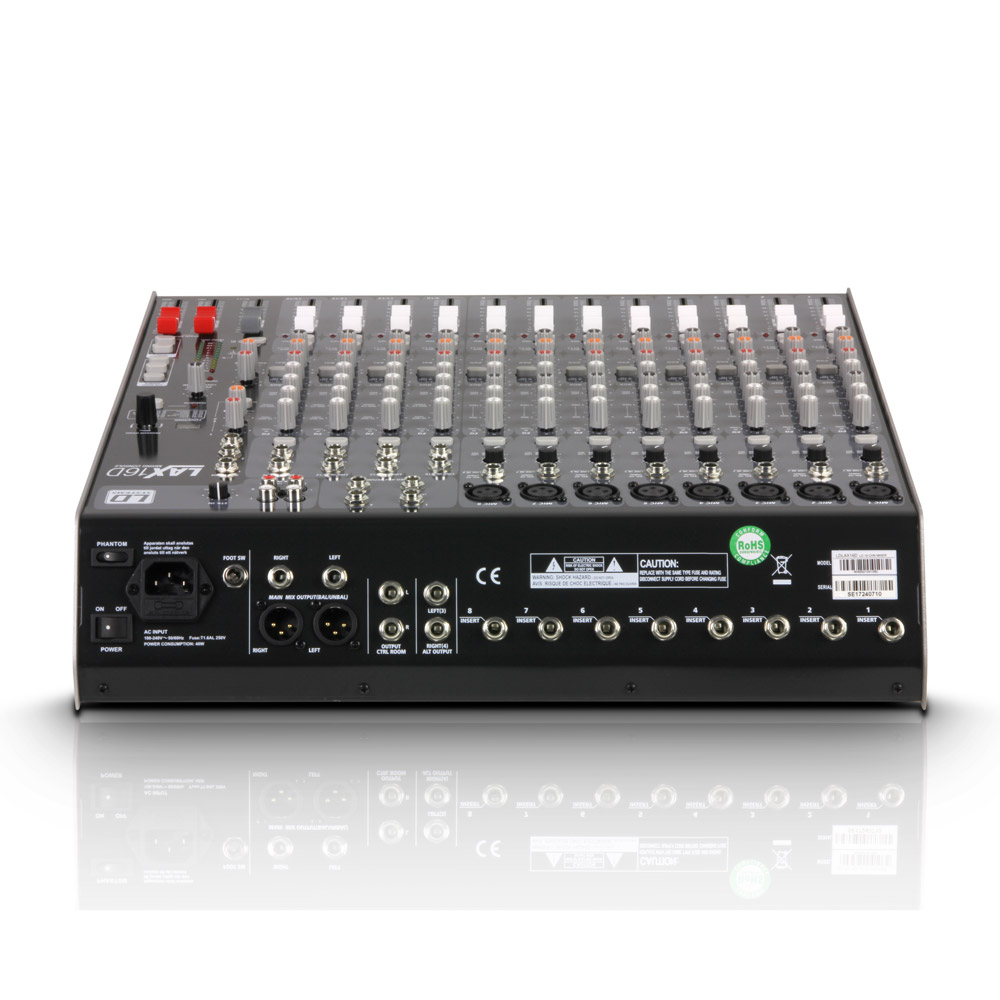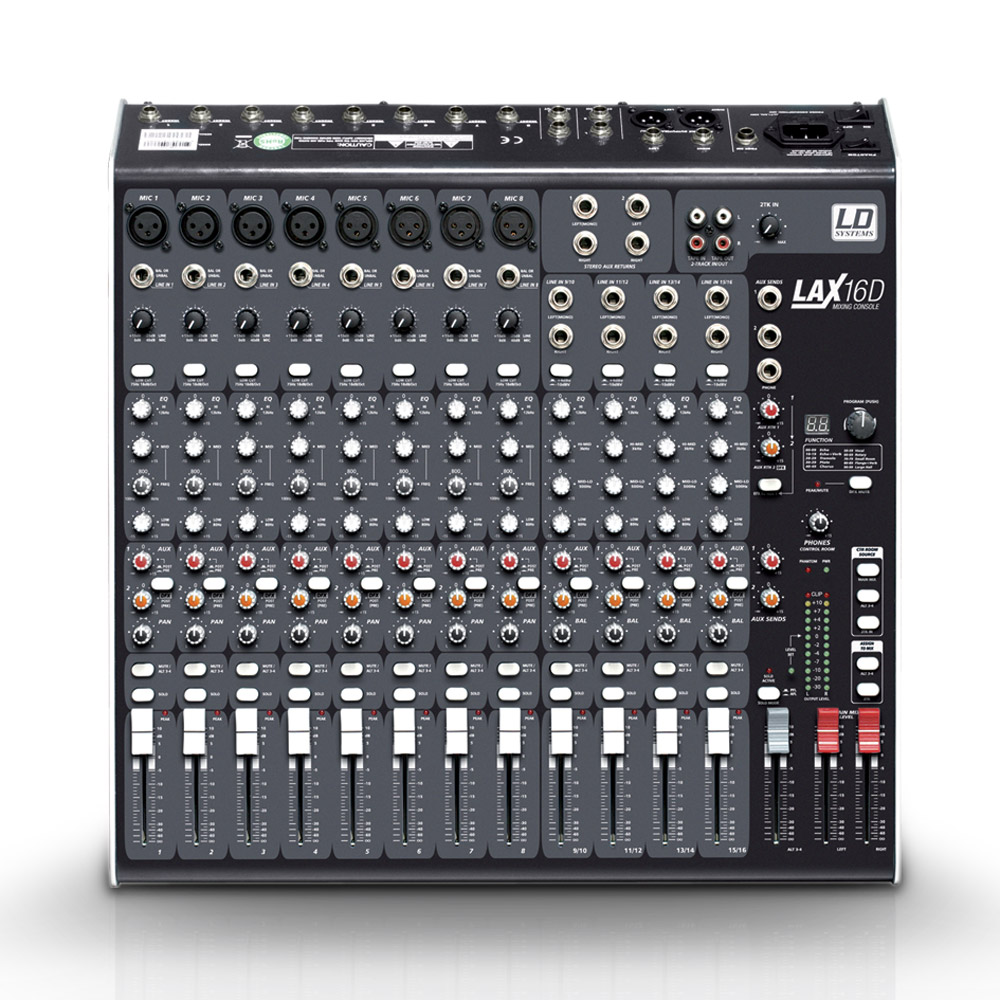LD Systems LAX16D – Test report from Future Music
With the versatile LAX range, LD Systems offers the right product for a variety of mixing processes – whether for individual applications on five channels, for studio recordings or complex live sounds. The flagship product is the LAX16D that we are testing today.
The LAX16D from LD Systems offers 16 channels, 8 mic inputs with switchable phantom power, and a 24 bit internal effects processor. All of it is integrated into a very compact housing with dimensions of 420 x 436 x 86 mm, weighing little more than 6.5 kg – a true featherweight considering what is included.  We want to find out whether the equipment of the LAX16D is sufficient for the typical requirements of home studio productions or suitable for projects requiring the mixing of various sound sources or instruments (including mics). In addition, we are keen to find out how it performs with other applications, such as live mixing and PA sets.
We want to find out whether the equipment of the LAX16D is sufficient for the typical requirements of home studio productions or suitable for projects requiring the mixing of various sound sources or instruments (including mics). In addition, we are keen to find out how it performs with other applications, such as live mixing and PA sets.
System inputs and outputs
The first eight channels of the LAX16D receive signals from eight balanced mic inputs/line inputs with adjustable gain, which are equipped with XLR connectors and sockets for ¼” jacks. Additionally, there are eight further channels with unbalanced plug connections, which are distributed on four stereo inputs. These are equipped with a convenient switch, used to choose between the normal signal strengths of professional applications and “applications for everyone” (+4 dBu/-10 dBV). On the rear panel of the LAX16D from LD Systems – this is slightly bevelled to improve the ease-of-use – there are eight pre-EQ-inputs (for ¼” plugs), to conveniently connect dynamics processors such as compressors and limiters or other external effects. There are two XLR outputs (balanced) and two jack plug outputs (unbalanced) as well as an alternative output “3-4”. The latter, in combination with the Mute switch provides for each channel additional options for signal routing and thus accommodates an alternative output group with direct control from the console.  The LAX16D has two AUX send buses for its 16 channels. The signal routing of AUX1 is configurable as a pre-or post-fader; AUX2 functions only as a post-fader. The mixer console is equipped with two stereo AUX returns with plug connections. So far, no unpleasant surprises. Reference monitors can be connected to the “CTRL Room” output. A recording input/output (RCA connector) with assignable routing allows the addition of two more signals to the console. So that makes a total of 18 inputs. And should it be necessary, the AUX returns can be used additionally, so that up to 22 inputs are available for mixing.
The LAX16D has two AUX send buses for its 16 channels. The signal routing of AUX1 is configurable as a pre-or post-fader; AUX2 functions only as a post-fader. The mixer console is equipped with two stereo AUX returns with plug connections. So far, no unpleasant surprises. Reference monitors can be connected to the “CTRL Room” output. A recording input/output (RCA connector) with assignable routing allows the addition of two more signals to the console. So that makes a total of 18 inputs. And should it be necessary, the AUX returns can be used additionally, so that up to 22 inputs are available for mixing.
The channel spectrum in detail
Let us move on from considering the LAX16D from LD Systems and turn our attention towards its channel spectrum so that you may get a realistic idea of the capabilities of the device. For each mono channel, in addition to the signal input, an input level controller is available (Micro from 0 to 40 dB and Line from +15 to -30 dB). An LED level display below the channel fader indicates whether the input is busy. Furthermore, we have a 75 Hz high-pass filter with a slope of 18 dB/octave. This is useful for reducing noise at a low frequency, such as electrical hum and unwanted signals for voice recordings with microphones. In a mono channel, the equalizer operates on three frequency bands with highs of 12 kHz, and basses of 80 Hz (with +/-15 dB of boost or attenuation), while the adjustment of the middle frequencies is done semi-parametrically with a scanning trace between 100 Hz and 8 kHz. The stereo channels have no mids control, but for the equalizer, there are four tracks with 80 Hz, 500 Hz, 3000 Hz or 12 kHz. We now look to the controller of the AUX outputs and the Pre-/Post-Fader-switch for AUX1, which we have already mentioned above. Then we come to the panoramic stereo controller and the “Solo” – and “Mute” switches for the channels (with the option of routing to the alternative output “3-4”). Finally, we consider the channel fader with 80 mm sliding distance. The “Master” area is equipped with independent sliding rails for the left and right channels, another fader for the alternative output “3-4” and a three-colour LED meter display for the mixing strength with CLIP display. This is supplemented by two buttons to adjust the overall strength of the connections AUX1 and AUX2 as well as by controllers for source selection for the monitor outputs (“CTRL Room”). Lastly, we still have a switch for the solo function for monitoring, with which you can alternate between PFL (Pre-Fader Listen) and AFL (After-Fader Listen), as well as the compulsory controller for headsets.
Its great strength: the DSP
Our description of each area of theLAX16D from LD Systems has clearly demonstrated that this device allows for highly flexible mixing processes – both in terms of signal routing as well as in tone control and level adjustment. However its very great strength is to be found in the middle right part of the device. There is a simple and easily accessible internal effects processor with preset programs. This processor offers 100 presets with different types of processing (Reverb, Delay, Tremolo, Chorus and rotating speaker) as well as some common dual effects. An encoder with confirmation button and a Mute button are the only controllers in this section. The whole thing is complemented with a program number display (0-99) and an LED display for Peak/Mute. 
May the input be received and the games begin!
So far we have described in detail the LAX16D from LD Systems’ purely external features. Now, let’s see what it can do for your ears. First of all, the design and ergonomics of this mixer are to be praised: Everything is in sight and within easy reach, so that the device is ready to be taken in hand at the first use. In practice, both the pre-amplifier and the other inputs offer a wide range of adjustments with very low noise and distortion levels, as can be expected from a modern electronic device of this kind. The handling of the dynamic range is decent. There is plenty of headroom available for sources with large signal swings, and you need not fear any cut off through clipping amplitudes. Since the LAX16D from LD Systems is an analogue mixer, you have the option of arranging your channel saturation in a creative way. For this purpose, the input volume controller and the high-pass filter provide all the necessary flexibility. The equalizer options represent practically the entire character of a mixer, and play a key role when deciding for or against a device. LD Systems specifies that British EQ models have inspired the construction of this device, in this particular case and in this price range however, the equipment and the sound quality seem to us to be decisive. The equalizer function is good, no frills, but, thanks to its adjustment of the mids in the mono channels and the four fixed mark on the stereo channels, it offers great flexibility. The DSP effect processor also provides good results. Above all, we would emphasise its immediate accessibility and ease of use. Admittedly, there are no luxury features such as editable parameters or more in-depth controls. Thanks to some switchable global send effects, you don’t really need more than what you have: the device is easy to use, the 100 preset effects are well chosen, and the 24-bit resolution provides us with complete satisfaction.  Our final assessment The marketing strategy of LD Systems is clear and attractive. With the help of external suppliers, the company produces very functional products, with a focus on original design, reliability and above all consistent value for money. The LAX16D is a good example of this philosophy: The official list price for this mixer is € 375 (often cheaper). For this amount of channels and the wide range of features, this is very little money. LD Systems doesn’t consider low prices as an excuse to save money on options, flexibility and quality. On the contrary: The flexibility in signal routing, the natural sound in “standard quality”, the equalizer section – functional and no frills – and amenities like the internal effects processor form a very attractive package for this price level. The 80 mm sliding distance for the faders represents perhaps the biggest weakness. This is forgiveable, however, give the extremely compact format that allows for easy and convenient transportation of the device. We find the clear and logical arrangement of the other controls quite pleasant. In practice, there are thus no problems caused by confusing operating areas. We would have found it more convenient if the send and return jack sockets and other connections were located on the rear panel. However, the present arrangement facilitates creative patching, when the LAX16D is installed in a rack. And for all the slackers, an internal dynamics processor and an integrated USB port would, of course, be divine. However, our conclusion is quite simple: It would not be fair to expect more from the LAX16D from LD Systems; it is already a very functional unit with so many details. Everything it does – it does in an elegant, solid and decent manner, and at the price of a base model!
Our final assessment The marketing strategy of LD Systems is clear and attractive. With the help of external suppliers, the company produces very functional products, with a focus on original design, reliability and above all consistent value for money. The LAX16D is a good example of this philosophy: The official list price for this mixer is € 375 (often cheaper). For this amount of channels and the wide range of features, this is very little money. LD Systems doesn’t consider low prices as an excuse to save money on options, flexibility and quality. On the contrary: The flexibility in signal routing, the natural sound in “standard quality”, the equalizer section – functional and no frills – and amenities like the internal effects processor form a very attractive package for this price level. The 80 mm sliding distance for the faders represents perhaps the biggest weakness. This is forgiveable, however, give the extremely compact format that allows for easy and convenient transportation of the device. We find the clear and logical arrangement of the other controls quite pleasant. In practice, there are thus no problems caused by confusing operating areas. We would have found it more convenient if the send and return jack sockets and other connections were located on the rear panel. However, the present arrangement facilitates creative patching, when the LAX16D is installed in a rack. And for all the slackers, an internal dynamics processor and an integrated USB port would, of course, be divine. However, our conclusion is quite simple: It would not be fair to expect more from the LAX16D from LD Systems; it is already a very functional unit with so many details. Everything it does – it does in an elegant, solid and decent manner, and at the price of a base model!
Price: € 375
For more information about the LAX16D of LD Systems, please visit:
http://www.ld-systems.com/en/series/lax-series/lax-16-d-mixer-16-channel-with-dsp/
Special advantages
– Natural sound in “standard quality” with low noise and distortion levels and a wide dynamic range
– Solid and durable construction in military style with metal housing that withstands many adversities
– Compact design with a clear and logical layout that has a direct impact on the user experience
– And the icing on the cake: the DSP processor and the high flexibility in signal routing
Assessment
![]()
Regardless of its ultimate application purpose – whether as recording software via an audio interface in the home studio, for direct mixing applications or channel expansion and patch bay for a superior system – the LAX16D from LD Systems is a flexible device that can achieve good mixing results.
Source: http://www.futuremusic-es.com , Spain, January 2014
Leave a Comment
You must be logged in to post a comment.












